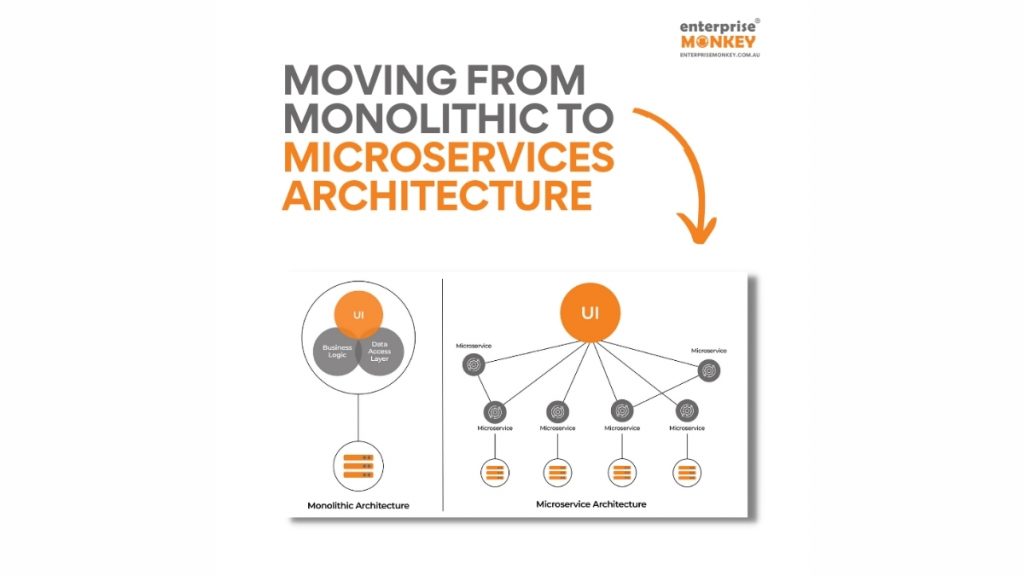Today’s application base is moving for a microservice approach to defeat the drawback of monolithic architecture. Before we move ahead to find the reasons behind the transformation of the monolithic approach to Microservices architecture, let you know about Monolithic architecture. Monolithic includes A Router, logic, database access.
Monolithic works as a single unit. Due to that, it has a tremendous responsibility to manage each function. It means that your application includes a single codebase, and you have to deploy that codebase as a single unit.
Suppose we take an example, a Monolithic server is there. All inputs are coming from various search engines like chrome, google, browser, or APIs. Then the server router decides which action to take for process or pass with specific logic. That logic defines what to do. If requests are in the stored database, it responds to whoever requests or inputs data through our build-up.
But this approach has some problems,
- Due to unit work, an error in a particular app segment leads to down the whole app system.
- It needs to implement an entire application for an update as it has a single large data codebase.
- It uses the same technology flow throughout the application process. The modifications in the stack are costly and also time-consuming.
Need to transform Monolithic service to Microservice approach,
If the system found a minor bug in the application, to solve that, small code lines are required, but in monolithic architecture, it needs to be built for the entire system. One more thing, scaling is also a big issue while dealing with Monolithic architecture; these types of flaws make obstacles to innovative ideas. Other drawbacks include the fact that we can use one technology platform, such as Java, C++, Python, and so on, which imposes many constraints. These are the flaws of a monolithic structure.
Now moving towards the Microservice features that enable developers to develop handy applications,
Microservice architecture and characteristics
As same as Monolithic, The model contains A Router, a Logical base, and data access. The Microservice model is a group of small service activities which have to design better scalable applications. Each service has its framework, developer language, and database. Their development and deployment process is separate from interprocess communication to connect through HTTP or binary protocols like TCP.
Characteristic Strengths of Microservice:
The microservices model allows different services to be worked on independently without affecting the performance of other parts. When a business grows, its workforce and demands increase, so can its application improve. Using microservices, you no longer have to deal with the problems associated with a monolithic architecture.
In addition, each service is self-contained and independent of the others. To put it another way, ‘I own my data.’ An illustration of this would be that the login management module handles user data. If you allow others to view user data, you’ll have to enable them to do so via your user management module rather than directly from your databases.
How to migrate Monolithic to Microservice
Mainly the challenges while transforming Monolithic architecture to microservice are regarding databases. Users expect their engagements with a computer to deliver the appropriate data in the proper amount of detail, typically as quickly as possible. Each user task entails one or more data items, and each data object connects with several procedures that can be done. The design team responsible for the service’s design and implementation must consider grouping jobs, data items, and activities.
Steps
Migrating from a monolithic approach to a microservices-based platform often includes the following stages:
- First of all, developers have to identify the logical concept behind the system.
- Components of architecture should be flat and refractory. Components are a group of data objects. The modifications carried out on data objects are encoded in software methods and functions located in libraries. The logic of the group is concerned with software libraries. It might be possible that the process can change the current structure of components to meet migration requirements.
- The dependencies should have clarity for designers.
- Characteristics of the component set are essential to work for other processes.
- After knowing all setting parameters, create an API for remote access.
- Then move all component sets to sorted projects and implement the component individually. It is a migration of component groups to microserviceThis.
- Then after it is easy to convert that macro services to microservices. Macro services are similar to microservices but somewhat different in that macro services can share datasets with other macro services or monolithic methods. And another one is that it allows access to multiple objects to complete the task.
- Until all the components and groups transform, you have to repeat this process.
The ability to extract components, data objects, and functions from the monolithic system and separate them into macro services reveals how these components might convert into microservices. It should consider that each microservice manages its datastore. It performs only a limited set of operations on the data objects it contains.
The preinstalled applications will migrate with optimum efficiency and minimal disruption. They are using this microservices migration strategy. It enables organizations to reap the advantages of microservice architectures such as increased resilience, scalability, lesser duration, and more straightforward maintenance.
So, which will be better for you?
Go with the Monolithic approach, if
- You have a small workforce and fewer assets to work with or startups.
- A simple and easy application that is not purposefully for business demands.
- If you want to develop a straightforward application to launch as soon as possible, Monolithic will be the better option.
Go with Microservice architecture, when
- Expertise staff to handle and manage the operations of Microservices as it is working on complex tasks.
- If your purpose is to complete the business demands with innovative ideas and modifications to scaling and emerging new things, microservice will be the best for you.
- It will help if you have well-maintained engineering staff to work efficiently on service capabilities.
Conclusion
These articles examine migration from monolithic to microservice architectures and detail the methods’ difficulties and advantages. Also, elaborate about the preferable plans to benefit from delivering good and well-managed service.












